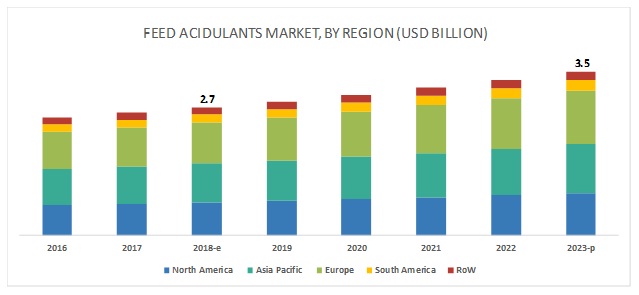
The high threat of diseases among livestock and increasing government aid promoting the growth of the feed industry are the factors driving the market for feed acidulants. MarketsandMarkets expects the feed acidulants market to grow from USD 2.7 billion in 2018 to USD 3.5 billion by 2023, at a CAGR of 5.1% during the forecast period.
The blended compound segment is projected to grow at a higher CAGR during the forecast period, in terms of value and volume. Blended acidulants are a mixture of different organic acids such as propionic acid, citric acid, and formic acid, among others. Blended acidulant compounds help reduce the presence of harmful microorganisms in feed, in addition to promoting beneficial microbial growth in the gut. Conversely, the addition of antibiotics inhibits the growth of any microorganisms, even if they are beneficial to the livestock. There are different blends of feed acidulants available; however, according to Nico Kors (Corbion NV), the blends of lactic, formic, and propionic acids are the most popular among animal breeders. These are the major factors driving the growth of blended compound acidulants in the feed acidulants market.
Request for Customization @ https://www.marketsandmarkets.com/requestsampleNew.asp?id=268013619
The poultry segment is estimated to dominate the market for feed acidulants in 2018. It is also projected to grow at the highest CAGR during the forecast period. The production of poultry meat is estimated to dominate and account for more than half the growth of the meat produced by 2025. This rapid growth in poultry meat production is expected to further increase the demand for superior-quality feed and feed additives, thereby driving the market for feed acidulants.
In terms of geographic coverage, the feed acidulants market has been segmented into five regions, namely, North America, Asia Pacific, Europe, South America, and RoW. South America is projected to record the highest growth rate during the forecast period, owing to the development of the animal husbandry sector in the region that has promoted an increase in the consumption of feed additives such as acidulants. The growing consumption of feed and feed supplements by livestock in the region are expected to stimulate the growth of feed acidulants in the South American region. Additionally, rising income levels in emerging economies such as Brazil and Argentina are supporting consumer inclination for better-quality meat and other livestock products, increasing the demand for meat from South America (mainly from Brazil and Argentina) in international markets such as countries of Europe, China, and other countries.
Read more @ https://www.marketsandmarkets.com/PressReleases/feed-acidulants.asp
The use of encapsulation technology in the feed additive industry is expected to provide potential growth opportunities for the feed acidulants market in the future. Feed acidulants have positive effects on livestock health but are often difficult to process in feed. Acidulants tend to lose their efficacy and efficiency, owing to their vulnerability to high temperatures, dusty environment, significant odors, and other volatile properties. As a result, manufacturers are now coming up with newer technologies that help improve feed efficiency by successfully locking in feed acidulants, along with their relevant efficacies and properties. Encapsulation acts as a novel technology for feed products, especially for acidulants that allow them to improve their release and enteric action and have a longer shelf life by protecting them against environmental changes, by keeping the liquid or solid acidulant substance packed in a tiny millimetric capsule. These acidulants are encapsulated in such a manner that the digestive tract obtains small quantities of various acids in a progressive manner. As a result, the amount of acidulants released into the stomach remains low while the amount reaching the intestinal tract is higher, thereby improving operating efficiency. Along with this protection against extreme environmental factors, encapsulation also maintains the key properties of acidulants, such as the enhancement of palatability, stability in the ration, improved digestion, and better livestock performance.